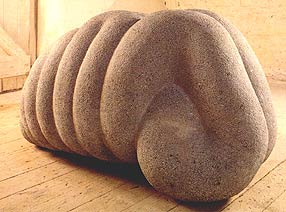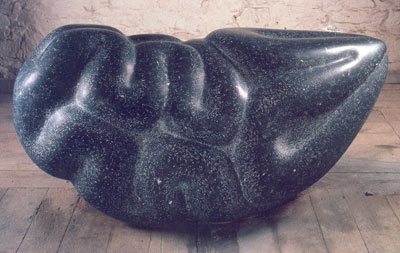There are also linocuts in the exhibition and they work in a slightly different way. It's more of a sculptural process. The resistance of the material is critical to me; the friction of the tool on the mo, or the charcoal on paper, determines the feel of the drawing. Many of the drawings have a lot of black in them; it's a bit like carving, starting with a block and chipping away the bits you don’t want.
I approach drawing in a similar way, starting with a white piece of paper and blacking in all that I don’t want to remain. Particularly on big drawings, it's a process of whittling away at the white.
Paul Nesbitt:
Your drawings and sculpture look as if they re all very carefully planned out, but I'd like to know how they evolve, and especially the role symmetry plays in this.
Symmetry is important. Almost all the sculpture I make is, broadly speaking, symmetrical but not absolutely so. The lack of mechanical symmetry is important because absolute symmetry has a coldness about it and the same applies with the drawings. They tend to have symmetry but it isn't a measured symmetry - it's determined by the eye...
...
Paul Nesbitt: What attracts you to plant rather than animal forms in your work?
I’ve never been interested in making sculpture which implies frozen movement or ‘a moment in time’. I’d like to make things which are at rest, where the energy is internalised. Perhaps plant forms, particularly fruit and seeds, lend themselves to this sense of implicit life. They may have the feeling that they could burst into life but from the inside rather than in an obviously animated way.
Paul Nesbitt:
There is also the treatment of botany and zoology as separate subjects. We’ve always had the difference between the animal and plant kingdoms emphasised, whereas in actual fact they both evolved together. All higher life forms begin as a cell which divides and multiplies and yet there's this very deep-rooted division which exists in society between the perception of animals and plants. But what you re actually doing is going to the core of things; in fact, some of your work is quite disconcerting because of this ambiguity
I think we have a much closer connection with other living things, both flora and fauna, than we realise. We are all part of the same biological system and my desire is not only to know this intellectually but to feel it in my bones. The blurring of boundaries between zoology and botany in my work is, in some ways, an expression of this desire to lose a sense of alienation from the rest of the natural world and to experience the reality of its intimacy...
Excerpts from Arts Dialogue, February 2000, pages 16 - 18
Excerpts from the catalogue, In mind of Botany, produced for his exhibition in the Kew Gardens Gallery, Royal Botanic Gardens, Kew, U.K. in 1996.
The catalogue illustrates 50-60 drawings and is for sale for £5 plus £2 p&p from Peter Randall-Page, P.O. Box 5, Drewsteignton, Exeter, Devon, EX6 6YG, U.K.
|
 Font, 1991 Kilkenny limestone, water and gilded pebble, 94.7 x 82.4 x 73.4 cm  Zai-Fuzai (Presence - Absence) 1992, Granite, located in a wooded headland near the village of Aio-cho, Yamaguchi Prefecture, Japan.
by Peter Randall-Page, U.K.  She-Bull She-Bull, 1995, Kilkenny limestone,
by Peter Randall-Page, U.K. |









